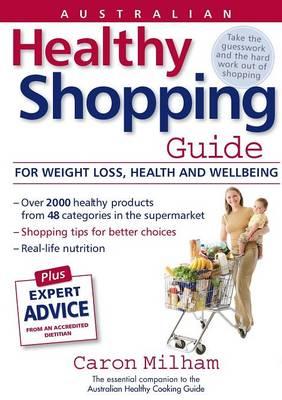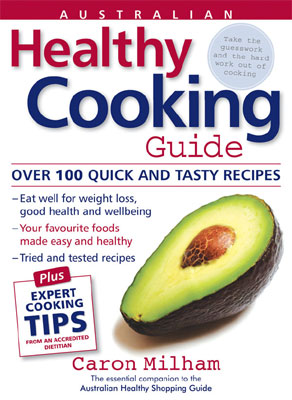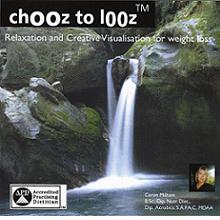Introduction to our Products
We would like to introduce our popular valuable products including our best-selling books, audio files and cd's. Over 100,000 copies have been sold in Australia of the The Australian Healthy Shopping Guide and the Australian Healthy Cooking Guide. To find out more about how these books may assist and guide you and/or to purchase online, please click on these links above.
Our Chooz to Looz Relaxation and Creative Visualisation CD & Audiofile is a great resource to help manage stress induce eating and to reprogram your sub-concious mind for success with weightloss with the positive affirmations and visualisations. You must think slim to be slim! To learn more about how this CD & or Audiofile may assist you and/or to purchase online please click on the link above.
Supachocs - gourmet, guilt free treats are our latest product. Please click on the SupaChocs link to find out more and/or purchase.
Buy our Products
Ordering online
The Australian Healthy Shopping Guide, the Australian Healthy Cooking Guide and our other products are all now available online.
PayPal Purchases
All purchases can be made using Paypal, which is a convenient and secure transaction service.
You do not need to have a Paypal account and payment methods include Visa, Mastercard or Bank Deposit. By buying our products online, you are not only agreeing to our terms and conditions but those of Paypal as well.
Australian Healthy Shopping Guide
Do you ever get confused when shopping for food products? The Nutrition or Health claim on a food label can ‘seduce’ us into purchasing a particular product, because we may think it is the ‘healthier’ option. It may very well be, but it also may not.
- Over 2000 brand names from 48 food categories to help you shop smart every time.
- Fully revised and expanded!
- Want to choose the best and healthiest food for you and your family when you go shopping?
- Cut through the claims and select the smartest options.
It's almost as handy as having a dietitian in the supermarket with you telling you which products are best!
RRP $24.95 (AUD) (print)
ADD TO CART By clicking the 'Add to cart' button, you are agreeing to both our terms and conditions and those of Paypal as well.
Australian Healthy Cooking Guide
Do you often wish that you and your family could have a long and healthy life? Do you dream of staying slim by eating wholesome, delicious and easy-to-prepare meals?
Do you yearn for more hours in the day and wish you had more energy to maintain a good balance in your life? The Australian Healthy Cooking Guide shows you how, by taking the hard work and guesswork out of shopping, cooking and preparing great food.
There are many delicious and practical food short cuts that don’t involve sacrificing health and taste. The AHCG shows you where to start, what to cook and how to plan for a healthy outcome.
RRP $24.95 (AUD) (Print)
ADD TO CART By clicking the 'Add to cart' button, you are agreeing to both our terms and conditions and those of Paypal as well.
Relaxation and Creative Visualisation for Weight Loss CD & Audiofile
YOU MUST THINK SLIM TO BE SLIM
A description of Part 1 of this CD & AudioFile – Relaxation – 18 minutes
The first part of this chooz to looz CD (and Audiofile) begins with a practical relaxation exercise for deep muscle relaxation. You will be taken through this exercise by Caron Milham, progressively relaxing and tensing the major muscle groups of the body. Soothing background ‘sounds of nature’ accompany this recording. The session finishes with some deep breathing exercises and a ‘Quick Release’ relaxation technique that you can use any time when confronted with a stress inducing situation.
A description of Part 2 of this CD (and Audiofile) - Creative Visualisation for Weight Loss – 20 minutes
The second part of this chooz to looz CD (and Audiofile) is an exercise in Creative Visualisation for weight loss, where you will imagine yourself at your ideal weight. This will help program your subconscious mind which will, in turn, influence your conscious mind and hence, your actual behaviour, and ultimately, your weight (particularly if you practice regularly). If you want to lose weight, you must know the advantages of achieving your desirable weight. You must imagine yourself already at your ideal weight, and see yourself acting, thinking, walking, talking and living as a slim person. Your subconscious mind will then direct you so that your conscious mind obeys and goes into action, making you live, breath and act like a slim person. You will be reprogramming yourself for success. In order to change your weight, your self-image must change first. All growth starts on the inside of us and works it way out, thus you must think slim in the mind before you can be slim in the body. Caron Milham will be taking you through this visualisation, accompanied by varying, soothing, relaxing sounds of nature, including a variety of bird calls and sounds of waves breaking on to the shore.
RRP $24.95 (AUD)
By clicking the 'Add to cart' button, you are agreeing to both our terms and conditions and those of Paypal as well.
Learn more about how creative visualisation and positive affirmations can assist weight loss.
Contact Caron Milham & Associates
90 Black Road, Flagstaff Hill. SA. 5159
To make an enquiry please call or message: 0435 152 716 or Email: admin@milhamdietitians.com
Alternatively please complete the enquiry form below & then press submit...
We will respond to your enquiry within 24 hours






